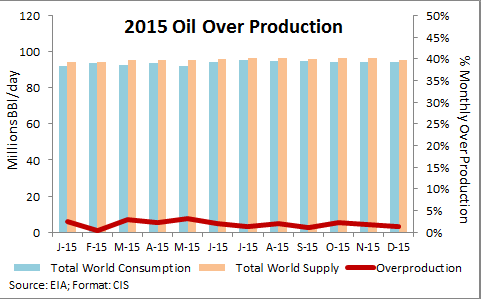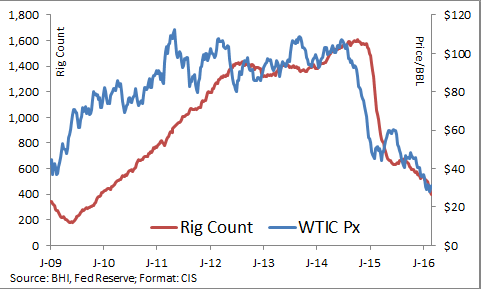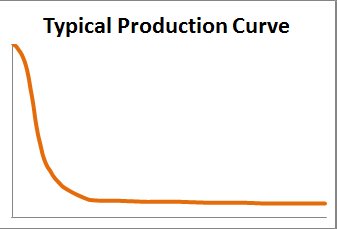What the U.S. Dollar Can Tell Investors About Oil Prices
Watch the Fed and U.S. dollar to figure out if and when oil may bottom and start to recover.

Won't $0.99 per gallon of gasoline be great? That is what some "experts" predict for the summer of 2016. Maybe it will happen; maybe it won't. What is for sure is that the price of oil has collapsed over the past year, and many U.S. oil companies have gone out of business.
So why did the price of oil drop so much? Was it overproduction from Saudi Arabia? Was it declining global consumption?
3 Myths About Why Oil Prices Dropped
1. Saudi Arabia's overproduction.
Yes, it is true that Saudi Arabian oil producers have been increasing output. But since the price of oil collapsed, the Organization of the Petroleum Exporting Countries (OPEC) increased its production by only 3.95%, according to data from the U.S. Energy Information Administration (EIA). World production was up 2.23% during the same period, according to the EIA. So yes, OPEC was producing oil at a faster rate than the rest of the world, but does a 3.95% increase really translate into a 75% decline in the price of oil? We don't think a 3.95% increase in supply justifies a 75% price decline. So it must be something else.
From just $107.88 $24.99 for Kiplinger Personal Finance
Become a smarter, better informed investor. Subscribe from just $107.88 $24.99, plus get up to 4 Special Issues

Sign up for Kiplinger’s Free Newsletters
Profit and prosper with the best of expert advice on investing, taxes, retirement, personal finance and more - straight to your e-mail.
Profit and prosper with the best of expert advice - straight to your e-mail.

2. Consumption has dropped significantly.
Where? In the U.S.? China? Europe? EIA data shows that global consumption since the peak price in June 2014 has been up 0.89% (or about 0.50%, annualized). Yes, this growth in annual consumption is slower than the average since 2000, which has been 1.27% annually, according to data from oil giant BP. So since mid 2014, consumption did not decline. It actually increased, albeit at a rate about 0.77% slower than average. Does a 0.77% decline in the growth rate really justify a 75% drop in the price of oil? No, we don't think so either. So it must be something else.
3. U.S. oil companies' troubles.
Rig counts have collapsed over the past year or so. According to oil field services company Baker Hughes, the number of rigs dropped from 1,609 in October 2014 to 400 in February 2016, a decline of 75%. This crash in rig counts indicates that U.S. oil companies didn't start failing until October 2014 at the earliest. But the price of oil started crashing earlier, in June 2014. Rig counts dropped due to the price of oil, not the other way around. (Of course some went under for reasons other than the oil price drop.)

Why Oil Prices Really Collapsed
In reality, the most likely candidate for why oil prices collapsed is the rise of the U.S. dollar. Oil is priced in dollars. And since June 2014, according to the Federal Reserve, the dollar has rallied 21%. As the chart below shows, if you invert the dollar, it parallels the decline in the price of oil. This is most likely the catalyst for the price decline.

So why did the U.S. dollar rally? Wasn't it the Fed's mandate to maintain price stability? Besides hurting the price of oil, a rising dollar hurts U.S. exports. Since June 2014, exports have declined 10%, according to the Federal Reserve's own data. Since the rising dollar hurt the price of oil, it has also decimated the oil business in the U.S.
Why did the Fed drop the ball on the dollar? Did they not see how it would impact the price of oil? They intervened to keep interest rates low and to keep stock prices from collapsing. But what happened with the U.S. dollar? This oversight indicates a lack of leadership and control at the Fed.
The fallout from the U.S. dollar's rally has been the decline in the price of many commodities, not just oil, troubles in the emerging markets since much of their debt was priced in U.S. dollars and a decline in U.S. exports. In my opinion, the Fed is directly responsible for the U.S. dollar's rally and the resulting problems.
So what does this mean? Eventually the dollar should come back to where it belongs, at a level much lower than the current price. This should benefit exports, the U.S. economy in general, the price of oil and other commodities and the emerging markets. But in the meantime, the Fed may allow the dollar to rally further. So the key is to watch the U.S. dollar.
What does an investor do? Realize that the current situation with anything that is related to the price of the U.S. dollar is in a temporary, artificially manipulated state. However, oil may bottom, and maybe even recover, sooner than many think. This is due to the production curve of oil wells.

Many people think that once a well is drilled, oil comes out in a continuous flow. That isn't the case. The typical production curve for a well is a steep drop in the first few years until it flattens out, producing maybe only 10% to 20% of the first year's production each year for the next 20 years or more.
If you look at the chart earlier in this column that compares the number of rigs with the price of oil, you will see that the rig count peaked a little over a year ago. This means the production of the last rigs that came online may soon decline rapidly. After years of rising production, the U.S. could see declining production in the next few months. This could put a floor on the price of oil. If the production decline is steep enough, it may actually offset the U.S. dollar's rally. Even if it does continue to rally, the impact on the price of oil may not be as bad as it has been over the past 18 months.
The key is still the U.S. dollar, but if U.S. oil production starts to decline, it may signal that the worst for oil prices may be over.
John Riley, registered Research Analyst and the Chief Investment Strategist at CIS, has been defending his clients from the surprises Wall Street misses since 1999.
Disclosure: Third party posts do not reflect the views of Cantella & Co Inc. or Cornerstone Investment Services, LLC. Any links to third party sites are believed to be reliable but have not been independently reviewed by Cantella & Co. Inc or Cornerstone Investment Services, LLC. Securities offered through Cantella & Co., Inc., Member FINRA/SIPC. Advisory Services offered through Cornerstone Investment Services, LLC's RIA. Please refer to my website for states in which I am registered.
Profit and prosper with the best of Kiplinger's advice on investing, taxes, retirement, personal finance and much more. Delivered daily. Enter your email in the box and click Sign Me Up.

In 1999, John Riley established Cornerstone Investment Services to offer investors an alternative to Wall Street. He is unique among financial advisers for having passed the Series 86 and 87 exams to become a registered Research Analyst. Since breaking free of the crowd, John has been able to manage clients' money in a way that prepares them for the trends he sees in the markets and the surprises Wall Street misses.
-
 The Stoic Retirement: Ancient Wisdom for Today's Reality
The Stoic Retirement: Ancient Wisdom for Today's RealityA "Stoic retirement" doesn't mean depriving yourself. It's a character-based approach to life and aging that can bring calm and clarity.
-
 My Teen Crashed His Car and Now Our Insurance Has Tripled. What Now?
My Teen Crashed His Car and Now Our Insurance Has Tripled. What Now?Dealing with the costly aftermath of a teen car accident is stressful. Here are your options for navigating it.
-
 11 Outrageous Ways To Spend Money in Retirement
11 Outrageous Ways To Spend Money in RetirementWhether you have excess cash to spend or want to pretend, here’s a look at 11 ridiculous ways retirees can splurge.
-
 I'm a Financial Planner for Millionaires: Here's How to Give Your Kids Cash Gifts Without Triggering IRS Paperwork
I'm a Financial Planner for Millionaires: Here's How to Give Your Kids Cash Gifts Without Triggering IRS PaperworkMost people can gift large sums without paying tax or filing a return, especially by structuring gifts across two tax years or splitting gifts with a spouse.
-
 'Boomer Candy' Investments Might Seem Sweet, But They Can Have a Sour Aftertaste
'Boomer Candy' Investments Might Seem Sweet, But They Can Have a Sour AftertasteProducts such as index annuities, structured notes and buffered ETFs might seem appealing, but sometimes they can rob you of flexibility and trap your capital.
-
 Quick Question: Are You Planning for a 20-Year Retirement or a 30-Year Retirement?
Quick Question: Are You Planning for a 20-Year Retirement or a 30-Year Retirement?You probably should be planning for a much longer retirement than you are. To avoid running out of retirement savings, you really need to make a plan.
-
 Don't Get Caught by the Medicare Tax Torpedo: A Retirement Expert's Tips to Steer Clear
Don't Get Caught by the Medicare Tax Torpedo: A Retirement Expert's Tips to Steer ClearBetter beware, because if you go even $1 over an important income threshold, your Medicare premiums could rise exponentially due to IRMAA surcharges.
-
 I'm an Insurance Pro: Going Without Life Insurance Is Like Driving Without a Seat Belt Because You Don't Plan to Crash
I'm an Insurance Pro: Going Without Life Insurance Is Like Driving Without a Seat Belt Because You Don't Plan to CrashLife insurance is that boring-but-crucial thing you really need to get now so that your family doesn't have to launch a GoFundMe when you're gone.
-
 I'm a Tax Attorney: These Are the Year-End Tax Moves You Can't Afford to Miss
I'm a Tax Attorney: These Are the Year-End Tax Moves You Can't Afford to MissDon't miss out on this prime time to maximize contributions to your retirement accounts, do Roth conversions and capture investment gains.
-
 I'm an Investment Adviser: This Is the Tax Diversification Strategy You Need for Your Retirement Income
I'm an Investment Adviser: This Is the Tax Diversification Strategy You Need for Your Retirement IncomeSpreading savings across three "tax buckets" — pretax, Roth and taxable — can help give retirees the flexibility to control when and how much taxes they pay.
-
 Could an Annuity Be Your Retirement Safety Net? 4 Key Considerations
Could an Annuity Be Your Retirement Safety Net? 4 Key ConsiderationsMore people are considering annuities to achieve tax-deferred growth and guaranteed income, but deciding if they are right for you depends on these key factors.